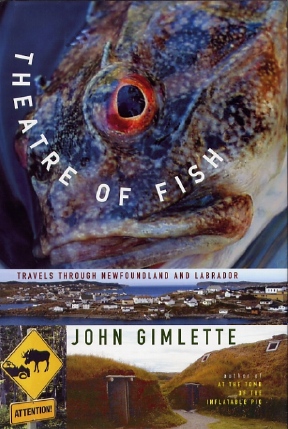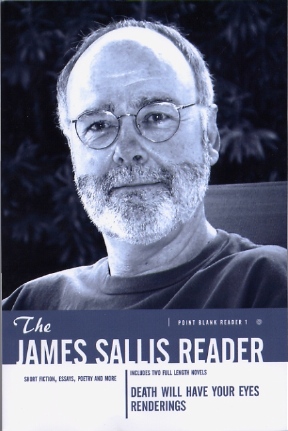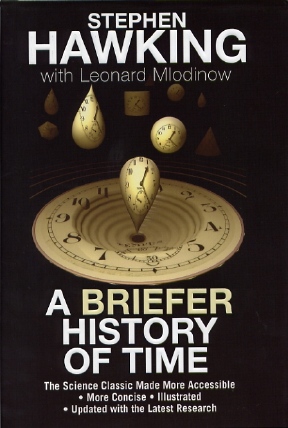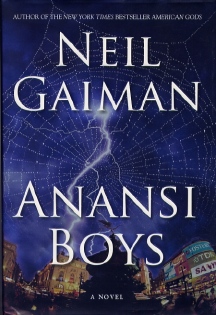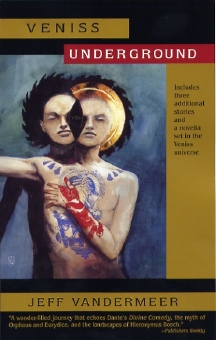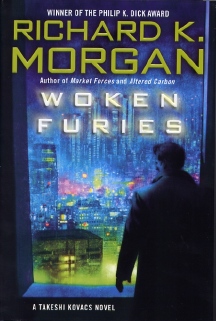|
|
|
This Just In...News from the Agony Column
|
09-30-05: John Gimlette 'Theatre of Fish: Travels Through Newfoundland and Labrador' |
|||
"Schools
for three and bars for one"
Of course, any destination can become interesting in the hands of a good writer. Even the godforsaken rocky coasts of Newfoundland and Labrador can become the stuff of can't -put-it-down reading, given the right treatment. 'Theatre of Fish' (Alfred A. Knopf / Random House ; September 6, 20095 ; $25) by John Gimlette is the kind of book that's dangerous to pick up in the bookstore. If you're like me, and you like to test drive a book by flipping it open at some random page and reading, then youre likely to be pleasantly surprised by the unpleasant surprises that Gimlette springs on readers. "This, broadly speaking, was the same route I took, as I set off in uncertain pursuit–in a car, of course, and without a rotting head." Well, you got me. And the follow-up ain't bad either. "I loathed Grand Falls, from my first lungful of steamy pulp to the last bungalow of its dreary, pastel suburbs." So the guy can write an interesting sentence, no doubt about it. But his story here sounds just as interesting. Gimlette, who first documented his travels in Paraguay in 'At the Tomb of the Inflatable Pig', has a flair for finding locations to travel to that feature massacres. And in this case, fish. Lots of fish. You see, Gimlette's great-grandfather, Dr. Eliot Curwen (and I swear that Lovecraftian name-echo means nothing to me, nothing) traveled through Labrador and Newfoundland, with, as Gimlette explains, "twenty-seven pieces of luggage including a rifle, knickerbockers and a box of 'exploding bullets'. In 'Theatre of Fish', Gimlette follows in his great-grandfather's footsteps, through a landscape that was shaped not by a gold rush, but a...fish rush. You may wonder why youd want to read about a fish rush, until you read Gimlette. "It's been a bloody struggle. Fish has been the prize (if not the catalyst) in some nine wars around Newfoundland and Labrador: six with France, two with America and one with the Netherlands." Gimlette is one of those guys who can find the dark clouds behind every silver lining, and the historical slaughters behind the façade of any modern city. "From 1633 to 1811–almost half the colony's history–settlement was either banned or curtailed, in favour of fish. This makes the modern Newfoundlander at least partly the heir to defiance, born of fish-thieves and outlaws. Even as late as 1817, the colony's owners–the great 'Fishocracy'–were advocating that the entire population be departed and dumped in Jamaica." Gimlette's gift is that if he's grim and he frequently is, he's also funny. But most importantly, on the sentence level at least, Gimlette can simply write like nobody's business. There's not a page in this book upon which you wont find a very nicely turned phrase, something to grab you, something you'll remember, something that will transport you into Gimlette's world in such a way that even if the world itself is rather, well, dark, dreary, bleak and a bit scary, at least it's compelling. Yes, Gimlette may wander a bit. Is that, like, surprising, given that this is a so-called "travel book"? I mean, it's NOT like you're going to rush out and travel to Newfoundland, is it? It's a rock, splattered with bird shit and dead fish. And rotting fishing villages, called "outports". These are not places you really even want to visit, unless you travel by reading. And for readers, that's the whole idea. When you're tired of alien planets, when you've met enough elves to last you a lifetime, when fictional murder and mayhem begin to pale, there's always the planet upon which you sit reading. It offers a lot of destinations and some interesting fellow travelers. Yep, the world of reading. Armchair traveling. What more can you ask of a book than this; that it transport you. |
|
09-29-05: 'The James Sallis Reader' from Point Blank Press |
|||
Reasons
to Read, Reasons to Write, Reasons to Get Up at 3:30 AM
As chain bookstores devour one another, as countries and ideologies devour one another, as people just looking for the perfect date devour one another, folks like J. T. Lindroos of the Point Blank Press drag the sun out at 0-dark hundred in the morning with nothing more than a great book by a writer everyone should know about. But the good news doesn't stop here. This is the kick-off to a Point Blank Reader series, and if this book is any indication, then we really have something special to look forward to. Of course, with material like James Sallis, it's hard not to score big. Sallis is the author of 'Long Legged Fly', a book that I bought bezillions of eons ago from bookseller supreme Mark V. Ziesing. Should you be in need of great suggestions, Ziesing's catalogue is an excellent place to start. But nostalgia grips me and I digress. Sallis is best known for his low-key Lew Griffin mysteries, as exemplified by 'Long Legged Fly'. The Lew Griffin mysteries offer readers a swamp-deep New Orleans atmosphere, believable action and an unexpected but welcome portion of existential angst. They're literary novels of inner evolution, not slam-bang action. But Sallis has written much more than mystery. He's written science fiction, horror and lots of fascinating literary criticism. "At literary gatherings, asked about influences, I'm as likely to cite science fiction and horror movies of the Fifties as I am James Joyce or Albert Camus," he tells us on the back cover of this Reader. Now that is a perfect, pitch perfect resume for an Agony Column writer. And this Reader is a perfect get-acquainted package. I have to admit, that when I first saw the word "Reader" on the spine of this book, my heart sank a bit. I love Sallis' work, but too often collections that call themselves "Readers" end up being sort of "Floor Sweepings". Nothing annoys me more than an excerpt from a novel. I want the whole novel damnit. If you must give something that became a novel, I'll be happy to look at a short story that was later expanded, or something that was "fixed up". But this excerpt crap -- forget it! And that's frankly what I expected to find here, thus the heart-sinking action. Imagine my surprise when I actually note that 'The James Sallis Reader' includes not just one, but TWO full-length novels. Now that's what I'm talking about wanting in a reader, my friends. The novels in this reader include 'Death Will Have Your Eyes', an existential spy novel and 'Renderings', an experimental novel that mixes poetry, Proust and Rilke. So from the get-go, you know youre going to get a good picture of what Sallis is up to. Fortunately for Point Blank, Sallis trends towards short novels. One can only imagine what the Point Blank Robert Jordan Reader might be. One presumes such a Reader will remain in the land of the imagination. This volume, a handsomely produced trade paperback, includes seven sections. There's a pretty damn entertaining Introduction. Then, there is a section of short stories, which will blow away those who have shelved Sallis in the mystery-only section. There are pieces that have first speared in F&SF, Orbit, and on websites like Fantastic Metropolis and 3 AM. The short stories are followed by a selection of literary essays on the likes of Patricia Highsmith, David Goodis, Walter Tevis, Gerald Kersh and Paco Taibo. This is followed by the novel 'Death Will Have Your Eyes'. After that, you've got thirty pages of poetry, followed by Personal Essays. And then you finish, appropriately enough, with 'Renderings', which itself might seem to be a sort of personal essay. What it all adds up to is my idea of a Reader. A big swathe of work that shows the writer's full range. Complete pieces of work, complete novels, even. Criticism to provide a literary compass and essays to provide a personal compass. What you get then, is a map of James Sallis. Point Blank and JT Lindroos are to be commended for bringing Sallis to the forefront with this excellent collection. Moreover, they appear to be on a campaign to give the term "Reader" a good name. Now, I know, they'll not always be able to include entire novels. But the fact that theyre willing to do so speaks very well for them and their understanding of what readers want out of, well -- Readers. |
|
09-28-05: Can You Make It Shorter and Add More Pictures? |
|||
Building
the Better Hotcake With 'A Briefer History of Time' by Stephen Hawking
and Leonard Mlodinow
Now when I say little, I mean little. This is 162 pages, with an index, biographies, and a glossary, because well, you just dont know any of the BIG WORDS that accompany the BIG IDEAS. In, yes, this little book. Back when the original book came out, the nearest I was getting to science reading was Michael Blumlein's 'The Brains of Rats' and Philip K. Dick's 'Martian Time Slip'. So yes, I missed out on the original, and yes, I'll admit that a short, literally slick and illustrated version of the science classic is pretty damn appealing. Since we're all immersed in the New Space Opera of writers like Alastair Reynolds, Neal Asher, Peter F. Hamilton, Gary Gibson, Richard Morgan, Iain Banks, and Charles Stross, it seems like now might be the perfect time to buy what is effectively The Little Golden Book of Big Space Opera Ideas. Now I know you all have a soft spot for the Little Golden Books, right? Those kind of cheaply made children's books you probably read as a kid? Or read to your kids, or both? (Both, that's me.) I can't see the damn things now without wanting to break out into a "Where did my little babies go?" wail. (To college and high school, as it happens.) That's why I loved the Book of Zogg so much. Well, that and because it's dead-on brilliant. So back on track, it just seems to me that 'A Briefer History of Time' is pretty much the scientific primer (pronounced "primmer" for the purposes of this discussion) for all the space opera that had lodged itself on our must-read list. Being rather averse to science writing, science fiction and anything heavily hyped when the first one came out, I'll admit I never bought it and never read it. Sue me for my own stupidity. But at the time, I just didn't see the relevance of black holes to say, 'The Books of Blood'. Well, that's just dandy because this new one really looks to be a better hotcake. First off, Mlodinow and Hawking have gone back and elided the "lengthy explanations of purely technical concepts found in the original". I say that like it's a good thing, but you know, I'd like to have the hypertext Wiki-version so that I could click over to those explanations. But frankly, when they describe them like that in the promotional materials, one's eyes naturally glaze over. Glaze has only one decent use in this world, and that's doughnuts. This version is not only shorter, it is slick and illustrated. Pick it, up, you'll see what I mean. This is not cheap. This is heavy paper, color illustrations, everything you need to understand what's going on. There are 37 full-color illustrations here to get you through these 142 pertinent pages. Look, this is a science book, so do the math. That's more than one pitcher every four pages or so. These are small pages with pretty big print, so readability is very high. Glen Edelstein has done a very nice job of designing this book. But the real big draw here is that Hawking and Mlodinow have not only streamlined the book, they've updated it with 17 years worth of new science. String theory, dark matter and dark energy were the stuff of science fiction (comparatively speaking) back when the original was published. Now they're fodder for riffs in 'Absolution Gap' the conclusion of Reynolds' 'Revelation Space' series. The idea being that if you missed the first round of this book while you were, so to speak, bathing in blood, then here's your chance at a brand-new go round that is pretty much dead-on certain to improve your reading experience when you delve into some new Space Opera. And while you KNOW there will be a really souped-up twentieth anniversary edition, that anniversary is a pretty long ways away. In your immediate future are books like Hamilton's 'Judas Unchained' and Reynolds' 'Pushing Ice'. I'm guessing that future would be a bit brighter with the light Hawking's book shining upon your science fiction reading. And then of course, you can go back to bathing in blood. |
|
09-27-05: A Conversation With Aimee Bender |
|||
Evidence
of Things Unseen
Turns out she was the most charming, nicest girl in the world. She teaches literature and creative writing in her copious spare time, when she's not writing fiction so odd you'd be excused for thinking both it and she hailed from a different universe than ours, one about six inches to the right and left. I've uploaded the MP3 and RealAudio files of the unexpurgated version of our interview for my listeners to enjoy. Not that she said anything particularly controversial, but in the broadcast version of the interview I thought it best to leave out the parts where I surprised her with questions about getting published in the genre press. I have to admit that I was as genuinely surprised by her answers as she was by my questions. To me it seems there should be a big crossover between some of the more surrealist literary fiction and the more oddball genre fiction that was, for a brief and shining moment, called "The New Weird". But the bottom line fact of the matter is that the bigger genre fiction outlets pay quite a bit better than the literary magazines. And to my mind, lots of the stories in 'Willful Creatures' belong as much on Scifi.com or in F&SF as they do in the Missouri Review. With luck, you'll be seeing stories by Bender in genre fiction venues. She certainly deserves the exposure, and the accompanying award noms that I think she'll get if she manages to place stuff there. No matter who you are, you should give Aimee Bender a listen. She is a teacher, and some of that comes through when she talks about how she writes. Though she wasn't trying to offer or give advice, but rather simply describe what she does, it strikes me that anyone who wants to write anything, fiction or non fiction, could benefit from listening to her thoughts. The kind of clarity that she brings to the subject is refreshing for anyone interested in reading or writing. And hell, she's just funny too, as is her fiction. I mean, how can a little man in a cage not be funny. As long as you're not looking out through the bars. |
|
09-26-05: Gaiman, Morgan, VanderMeer |
|||||||||
Familiar Names and New US Titles
But the real reason to pick up an extra copy is simply to support the writers you like by providing them with ACTUAL SALES of their books, particularly here in the US. Sure we can talk them up all we want, but we also have to follow that talk with action. That's what the publishers respond to. Positive reviews are nice, but actual sales pay the bills. Normally, I suggest that readers buy all their books at independent bookstores. With the recent demise of San Francisco powerhouse bookstore Kepler's, this is more urgent than ever. The closing of Kepler's came as a shock to us all. It happened fast and nobody expected it. Take a gander at you favorite local independents. Living in Santa Cruz, I have lots of them, and I've supported them, but still some of my favorites have closed. Logos down town gets the once-weekly, or used to when I actually left my house more often. I try to get to my most local bookstore, Bookworks Aptos, cash in hand, on a regular basis, but am not able to do so as much as I'd like to. One of my favorites, Book Loft, closed up a while back. They were a used-only bookstore, and I'd picked up lots of great titles; they'd carried an extensive selection of SF and hardcover fiction Local powerhouses like Bookshop Santa Cruz and Capitola Book Café appear to be doing well, but appearances can be deceiving. I know that Capitola Book Café just cleaned up on a Pratchett signing. That's great news, but readers will need to get out support more obscure writers there as well. And I just dropped some $60 at Bookshop buying two signed copies of Neil Gaiman's 'Anansi Boys'.
Gaiman has asked that you NOT hie yourself down to the bookstores, buy up all the signed copies and then turn around and flip them on E Bay for some unseemly inflated price. I think as readers, we'd best listen to the writers in this regard. Here's the deal; when you start doing that, yes, you might make some money. And, yes, I think it's a good idea to pick up a couple of copies of the signed edition. Buy one to keep for your library, and buy one for your kids to sell to pay for some horrific medical treatment that you're likely to need when the government outlaws all forms of death. Or maybe something you can sell to help pay for about one ten-thousandth of their college education or whatever. But when you drive up the prices early with all that speculation, the writers dont make cent out of it, and the publishers look on with great annoyance crossing their wrinkled brow. They want a piece of that pie and theyre likely to do something unfortunate should you make that pie attractive enough to them. You'll also encourage bookshops to offer the books at above-cover prices. Please don't. On the other hand, 'Anansi Boys' is a must-buy. Like Jeff Ford's 'The Girl in the Glass' its got an across-the-board appeal that will be appreciated by a wide swathe of readers. You can hardly go wrong buying this book for just about anyone. In fact, heres what I suggest you do. Let's jump into heresy territory! OK, pop down to your version of Capitola Book Café / Bookshop Santa Cruz / Logos / Bookworks and pick up a signed copy. Check? Check. Next, call up your local chain, say Borders. Make sure they have the Jeffrey Ford novel in. If not, order it. Reserve a signed copy of the Gaiman at the same time. Then go down and pick up the Ford, the Morgan, the VanderMeer and the Gaiman at the chain. I'm really enjoying your apoplexy at this moment. The turning red and all? What has happened to me, to Rick Kleffel? Have I gone over to the dark side?
Over the top of what, I dont know. But what to my mind needs to happen is that the old midlist needs to get a heavy-duty shot in the arm. It's a dirty word in the biz now. Nobody wants to be associated with the midlist. The folks who want to maximize profit and minimize their own work would ideally like to publish exactly one book. Everybody wants to be a BESTSELLING BLOCKBUSTER. Guess the hell what? NOT EVERYBODY CAN BE A BESTSELLING BLOCKBUSTER. But lots of writers can make it with nice, steady sales to a predictable market. Readers like you guys, who enjoy simply good fiction. It doesn't have to be EVENT FICTION. In fact, one buys EVENT FICTION only in the most important cases, the most compelling writers. Gaiman. Barker. I'm corpsing on other names at the moment. It's 5:19 AM and caffeine rules my system. For about the same price you can see a totally worthless, stupid movie and get an stomach-scalding soft drink, you can buy Jeff VanderMeer's 'Veniss Underground' (Bantam Spectra / Bantam Dell / Random House ; October 4, 2005 ; $14.00). This is a pretty damn souped-up edition, with three stories and the novella 'Balzac's War'. You get a nice 1970's vibe cover. It reminds me of something that Abraham Ebdus from recent McArthur "genius grant" recipient Jonathan Lethem's 'The Fortress of Solitude' would paint. It's pretty classy, classy enough to look good with wasabi sauce on the pages. At fourteen dollah, you can buy one for someone you'd like to see with an exploded head. That 1970's vibe continues on the cover of 'Woken Furies' by Richard K. Morgan. It looks just like something I might have pulled out of the bookracks next to 'Mutant 59: The Plastic Eaters'. I hope you got your signed UK hardcovers, they're climbing in value now. But here's a very nice hardcover American version, and since I've been whinging forever-frigging-ever that Morgan deserved hardcover US publication, lets demonstrate that to the publishers and actually buy the thing, now it's FINALLY out. Even as I write I'm reading this one, slowly, savoring it. And you can guess that the UK version stays home with the white Demco gloves, while the US version does make a nice slab to take to the Falafel House downtown. Yes, this is definitely a book to savor. And the US version is nice enough to make one cautious as one tosses about the tahini sauce. Alas, the bottom line is the bottom line; we need to buy the books of the authors we love from bookstores big and small. Think of what a couple hundred special orders for 'The Girl in the Glass', the new Jeffrey Ford book, could do for him. Buy 'Anansi Boys' and Jeff VanderMeer's 'Veniss Underground', Morgan and Ford. Buy them for your friends. Buy them because if you don't, there might not be any more coming along. Publishers and a non-zero number of booksellers might be happy to just stock That Book, and the next Harry Potter, instead of the thousands of titles they currently carry. Support the thousands. The bottom line is ALWAYS the bottom line. |
